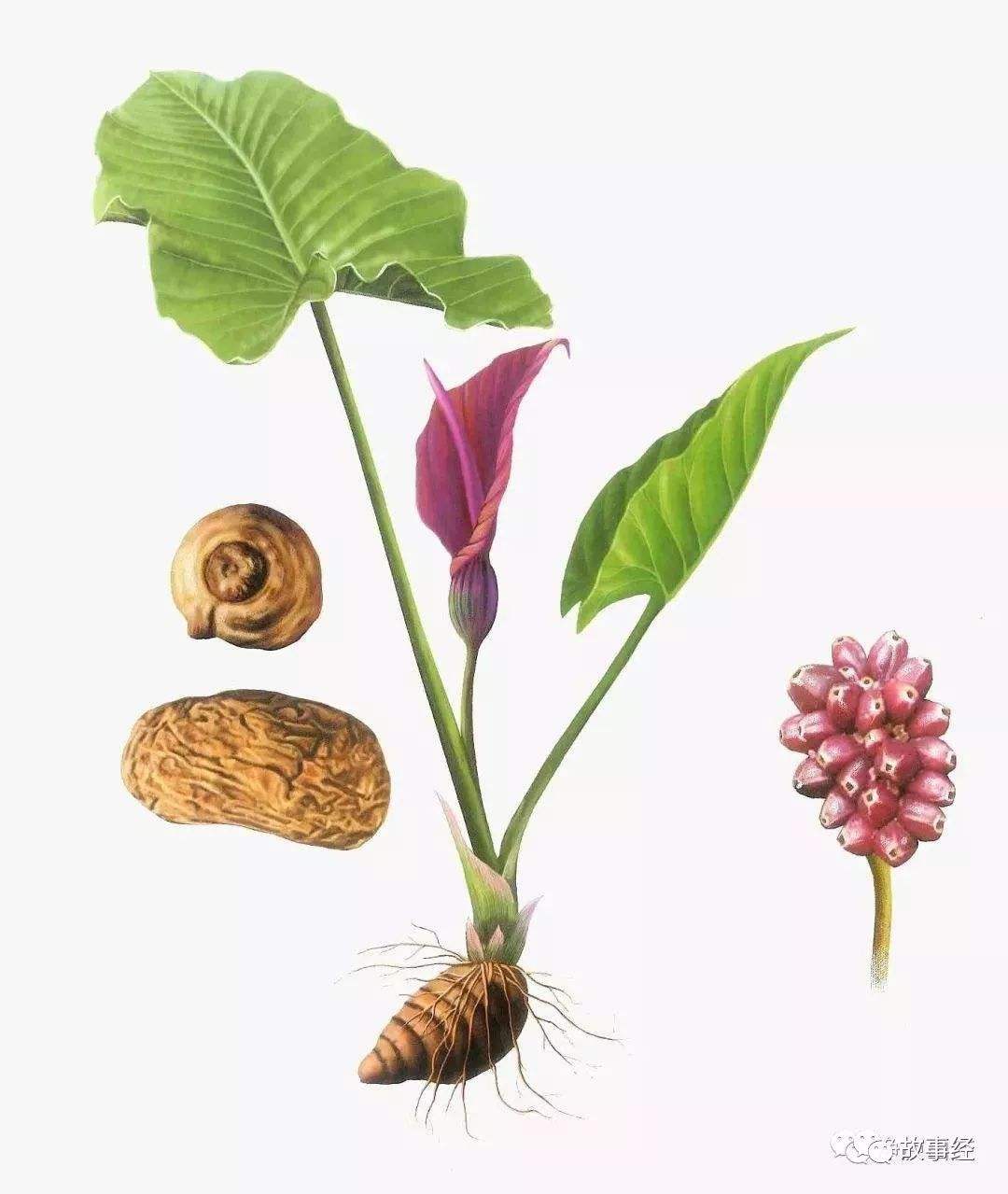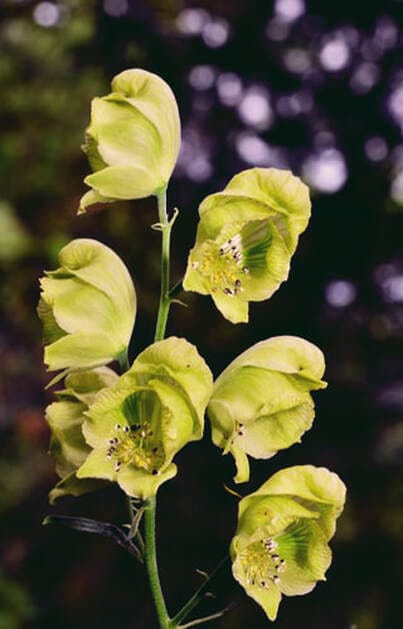Typhonium, Bai Fu Zi 白附子Prepared Root is called Zhi Bai Fu Zi |

|

|
 Typhonium giganteum
Typhonium giganteum Aconitum coreanum
Aconitum coreanum(Photo by IloveU4ever) (Wikimedia)
Botanical name:
Typhonium giganteum (syn. T. giraldii, T. stoliczkae)
Aconitum coreanum (A. koreanum, Guan Bai Fu) is used in some parts.
Parts used:
Prepared Root. The fresh root is used externally
Temperature & Taste:
Very warm, dry. Pungent, Sweet. Toxic
Classification:
P. Clears Cold Phlegm
Uses:
1. Settles Wind, Clears Phlegm and Damp, Stops Spams:
-Headache, Migraine, Dizziness
-Convulsions, Epilepsy
-Deviation of the Eye and Mouth, Impairment of Speech, Facial Paralysis, Hemiplegia
-Stroke, Cerebral Thrombosis
-especially for Wind-Phlegm affecting the Head and Brain
-also for Wind-Cold-Damp painful obstructions of the Joints and Muscles
2. Clears Phlegm, Reduce Masses:
-Scrofula, Lymphatic swellings and Nodes from Phlegm and Damp
-taken internally and the fresh herb can be applied topically
-also for Phlegm-Damp obstructing the Stomach, Nausea, Vomiting, Indigestion
3. Dries Damp, Settles Wind, Stops Itching:
-Eczema and other Damp skin rashes
-powdered herb can be applied topically
-also topically for fungal infections
4. Resists Poison:
-Snake Bite
5. Externally:
-Scrofula, Nodes
-Snake Bite
Dose:
Prepared Typhonium Root in Decoction: 2–6 grams, beginning with lower doses and increasing as required;
Prepared Typhonium Root in Powder: 500mg–1 gram
Prepared Aconitum koreanum Root in Decoction: 1500mg–5 grams
Externally, the raw root in beaten into paste, boiled to a soft extract, or the powdered root is mixed with wine and applied.
Comment:
1. Care must be taken in not confusing with Aconitum Fu Zi, the white variety of which is also sometimes called Bai Fu Zi. Commonly, Aconite will be referred to as Bai Fu Pian (White Aconite pieces), or Hei Fu Zi (Black Aconite), while Typhonium is called Bai Fu Zi.
2. The correct name for the prepared product is Zhi Bai Fu Zi. However, in common practice, when Bai Fu Zi is simply written, the prepared root will be supplied. When the unprepared root is wanted it will be specifically written as Sheng Bai Fu Zi.
3. Prepared Aconitum coreanum (Guan Bai Fu) is used synonymously. However, it is regarded as stronger for clearing Cold and relieving pain.
Substitutes:
1. Aconitum coreanum (Huang Hua Wu Tou) is used similarly, and is used as a substitute in Korea. Being an Aconite, it is more toxic, more Heating, and therefore better for Wind-Cold pain, Typhonium being more effective for Wind-Phlegm. The dose of Aconitum coreanum in 1.5–6 grams.
2. Arum root or Arisaema Tian Nan Xing
Preparation:
Prepared Typhonium Root:
Soak the sliced root in water for several days, changing the water 3 times daily. When the water becomes frothy, change the water again, then add Alum (2% the weight of the root). Soak for 24 hours and change the water until it has a slight numbing effect. Put slices of fresh Ginger and Alum in water (12.5% of the weight of the root), bring to the boil and add the root. Boil until the cut surface of the root has no dry core. Remove the roots, dry partially, cut into thick slices and dry. (Chinese Pharmacopoeia)
Prepared Aconitum koreanum Root:
The root is soaked in water for 1 week, changing the water regularly. It is then boiled with Bean Curd for half an hour, then dried, and sliced.
Main Combinations:
1. Headache, Migraine:
i. Typhonium with Angelica dahurica Bai Zhi, Ligusticum Chuan Xiong
ii. severe Headache or Migraine, add Scorpion (Quan Xie) to the above
2. Facial Paralysis, Hemiplegia:
i. Post-stroke deviation of the mouth and eyes: Typhonium with White Silkworm (Bai Jiang Can), Scorpion (Quan Xie) (equal parts). Powder, dose is 3 grams (as in Qian Zheng San)
ii. Typhonium with Dang Gui, Ligusticum Chuan Xiong, Safflower (Hong Hua), Peach kernel (Tao Ren), Wingless Cockroach Tu Bie Chong, Salvia Dan Shen, Earthworm (Di Long), Achyranthes Chuan Niu Xi, Scorpion (Quan Xie), Centipede (Wu Gong), Agkistrodon Jin Qian Bai Hua She (Snake).
3. Convulsions:
i. from Wind-Phlegm, Typhonium with Arisaema prepared with Bile (Dan Nan Xing), Pinellia Ban Xia, Gastrodia Tian Ma
ii. Childhood Convulsions, Typhonium with Bezoar (Niu Huang), Scorpion (Quan Xie), White Silkworm (Bai Jiang Can), Pear (Zhen Zhu)l, Amber (Hu Po), Tabasheer (Tian Zhu Huang), Gastrodia Tian Ma, Saposhnikovia Fang Feng, Mint (Bo He), Borneo Camphor (Bing Pian), Licorice (as in Niu Huang Zhen Jing Wan)
4. Epilepsy from Wind-Phlegm, Typhonium with Arisaema Tian Nan Xing, Pinellia Ban Xia, Centipede (Wu Gong), Scorpion (Quan Xie), Alum (Bai Fan) (as in Yi Xian Wan of the Chinese Pharmacopoeia)
5. Tetanus, Typhonium with Saposhnikovia Fang Feng, Gastrodia Tian Ma
6. Eczema from Wind-Damp:
i. Typhonium with Paeonia Bai Shao, Poria Fu Ling, Saposhnikovia Fang Feng
ii. Typhonium with Notopterygium Qiang Huo, Tribulus seed (Ci Ji Li), Astragalus Huang Qi
7. Pediatric Asthma, Typhonium with Agastache Huo Xiang (equal parts). Powder, give 1500mg–3 grams with rice soup (as in Bai Fu San)
8. Phlegm-Damp obstructing Digestion with Diarrhea, Indigestion, Typhonium with Poria Fu Ling, Pinellia Ban Xia, Citrus Chen Pi, Amomum Sha Ren, Paeonia Bai Shao, Atractylodes Bai Zhu (as in Bao Long Wan of the Chinese Pharmacopoeia)
9. Topically for deviation of the mouth, numbness, or pain of the muscles and joints, as a plaster Typhonium with Earthworm (Di Long), Scorpion (Quan Xie), Ligusticum Chuan Xiong, Saposhnikovia Fang Feng, Camphor (as in Fu Fang Qian Zheng Gao)
10. Snake Bite, Typhonium with Angelica dahurica Bai Zhi, Lonicera Jin Yin Hua, Fritillaria Zhe Bei Mu
Major Formulas:
Qian Zheng San
Bai Fu San
Yu Zhen San
Yi Xian Wan
Zhong Feng Hun Chun Wan
Niu Huang Zhen Jing Wan
Fu Fang Qian Zheng Gao
Cautions:
1. Not used in Pregnancy
2. Should not be used for Wind-Heat, Dryness, or Yin deficiency, as it is very drying.
3. Avoid overdose. Caution using the unprepared root internally
